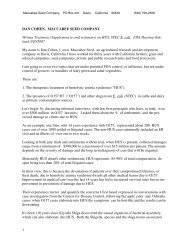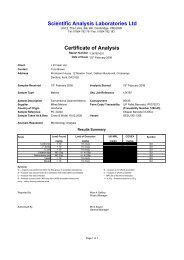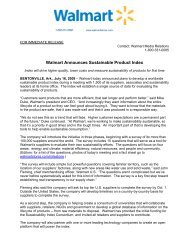here - Perishable Pundit
here - Perishable Pundit
here - Perishable Pundit
Create successful ePaper yourself
Turn your PDF publications into a flip-book with our unique Google optimized e-Paper software.
differences in fertilizer use (nitrogen andphosphorus) and ripeness at harvest (titratableacidity). T<strong>here</strong> was no difference for t<strong>here</strong>maining eight categories, including some keyones, including Vitamin C, phenolic compounds,magnesium, calcium, potassium, zinc, totalsoluble solids, and copper. The authorsconcluded that:“The current analysis suggests that a smallnumber of differences in nutrient contentexist between organically and conventionallyproduced foodstuffs and that, w<strong>here</strong>asthese differences in content are biologicallyplausible, they are unlikely to be of publichealth relevance.”The authors encourage more research in this area.The Scientific Status Summary on OrganicFoods from the Institute for Food Technologists(IFT) echoes the conclusions of the Londonreview (Winters and Davis, 2006). The IFTSummary discusses a variety of issuessurrounding organic foods, including: (1) levelsof pesticides, (2) nutritional value, (3) naturallyoccurring toxins, and (4) microbiological safety,and includes a summary of a number of keystudies comparing organic and conventionalfoods with respect to nutrient levels.The IFT Summary states:In some cases, organic foods may havehigher levels of plant secondarymetabolites; this may be beneficial withrespect to suspected antioxidants such aspolyphenolic compounds, but also maybe of potential health concern whenconsidering naturally occurring toxins.Some studies have suggested potentialincreased microbiological hazards fromorganic produce or animal products dueto prohibition of antimicrobial use, yetother studies have not reached the sameconclusion. Bacterial isolates from foodanimals raised organically appear to showless resistance to antimicrobial agents thanthose food animals raised conventionally.While many studies demonstrate thesequalitative differences between organicand conventional foods, it is premature toconclude that either food system is superiorto the other with respect to safety ornutritional composition. Pesticide residues,naturally occurring toxins, nitrates, andpolyphenolic compounds exert theirhealth risks or benefits on a dose-relatedbasis, and data do not yet exist to ascertainwhether the difference in the levels of suchchemicals between organic foods andconventional foods are of biologicalsignificance.”It is important to state that the nutrient levels innatural plants can vary for a wide variety ofreasons. It is plausible for plants grown underdifferent conditions, such as conventionalversus organic agriculture, to have differentnutritional qualities. However, t<strong>here</strong> is noconvincing reason to believe that any oneproduction method is consistently superior inregard to nutrition. This is borne out by theavailable data which shows mixed resultsregarding systematic difference betweenfoodstuffs grown with conventional versusorganic agriculture.It is also notable, as the IFT review details, thatt<strong>here</strong> is no convincing evidence of greatermicrobiological risk associated with organicfood, as some have suggested. Themicrobiological risk may be more related to thequality of the production method and theprevention of contamination than from theparticular production method used.12








